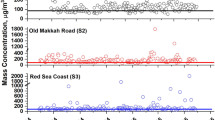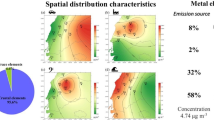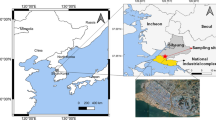Abstract
To identify the health risks of heavy metals and potential sources of children’s exposure to PM2.5, 36 students aged 9–12 were recruited in 2010 for a panel study in Tianjin, China. Si, Fe, Al, Mg, Ca, Ti, Zn, Pb, Mn, Cr, Ni, As, Cd, Co, nitrate (NO3 −), sulfate (SO4 2−), organic carbon (OC), and elemental carbon (EC) were analyzed. Potential health risks of heavy metals were calculated and sources were identified by positive matrix factorization (PMF). PM2.5 exposure to children in winter (122.4 μg m−3) was higher than in summer (74.7 μg m−3) (p < 0.05). The 14 elements, ions (NO3 − and SO4 2−), OC, and EC represented 14, 38, 40, and 4 % and 19, 39, 31, and 7 % of PM2.5 mass in summer and winter, respectively. Average NO3 −⁄SO4 2− ratios were 2.3 and 0.6 in summer and winter, respectively, indicating a seasonal shift in the predominance of mobile and stationary sources. Cr and Mn posed the highest carcinogenic and non-carcinogenic risks, respectively. The integrated carcinogenic and non-carcinogenic risks were, respectively, 3.4 × 10−3 and 2.8 in summer and 4.1 × 10−3 and 4.9 in winter, which indicated that attention should be paid to both carcinogenic and non-carcinogenic risks of heavy metals for children. In summer, secondary sources, vehicle exhaust, crustal dust, industrial source, and vehicle additives contributed 30, 29, 13, 21, and 7 %, respectively, to children’s PM2.5 exposure, while in winter, the contributions of the first four sources together with coal combustion and road dust were 26, 24, 14, 10, 20, and 5 %, respectively.




Similar content being viewed by others

References
Anderson JO, Thundiyil JG, Stolbach A (2012) Clearing the air: a review of the effects of particulate matter air pollution on human health. J Med Toxicol 8:166–175
Aschner M (2006) The transport of manganese across the blood-brain barrier. Neurocsi Toxicol 27:311–314
Aucélio RQ, Martins de Souza R, Calixto de Campos R, Miekeley N, Porto da Silveira CL (2007) The determination of trace metals in lubricating oils by atomic spectrometry. Spectrochim Acta B At Spectrosc 62:952–961
Chan YC, Cohen DD, Hawas O, Stelcer E, Simpson R, Denison L et al (2008) Apportionment of sources of fine and coarse particles in four major Australian cities by positive matrix factorization. Atmos Environ 42:374–389
Chen C, Zhu ZJ, Liu D, Wang YY, Shen JC (2013) Characteristic and source apportionment of atmospheric PM2.5 in Zhengzhou. Environ Monit Chin 29:47–52 (In Chinese)
Crist KC, Liu B, Kim M, Deshpande SR, John K (2008) Characterization of fine particulate matter in Ohio: indoor, outdoor, and personal exposures. Environ Res 106:62–71
Díaz RV, Dominguez ER (2009) Health risk by inhalation of PM2.5 in the metropolitan zone of the city of Mexico. Ecotoxicol Environ Saf 72:866–871
Dominici F, Peng RD, Bell ML, Pham L, McDermott A, Zeger SL et al (2006) Fine particulate air pollution and hospital admission for cardiovascular and respiratory diseases. J Am Med Assoc 295:1127–1134
Du X, Kong Q, Ge WH, Zhang SJ, Fu LX (2010) Characterization of personal exposure concentration of fine particles for adults and children exposed to high ambient concentrations in Beijing. J Environ Sci 22:1757–1164
Duan JC, Tan JH (2013) Atmospheric heavy metals and arsenic in China: situation, sources and control policies. Atmos Environ 74:93–101
Fang GC, Huang YL, Huang JH (2010) Study of atmospheric metallic elements pollution in Asia during 2000–2007. J Hazard Mater 180:115–121
Gao X, Yang L, Cheng S, Gao R, Zhao Y, Xue L et al (2011) Semi-continuous measurement of water-soluble ions in PM2.5 in Jinan, China: temporal variations and source apportionments. Atmos Environ 45:6048–6056
Gauderman WJ, Avol E, Gilliland F, Vora H, Thomas D, Berhane K et al (2004) The effect of air pollution on lung development from 10 to 18 years of age. N Engl J Med 351:1057–1067
Gauvin S, Reungoat P, Cassadou S, Déchenaux J, Momas I, Just J et al (2002) Contribution of indoor and outdoor environments to PM2.5 personal exposure of children—VESTA study. Sci Total Environ 297:175–181
Han JB, Han B, Li PH, Kong SF, Bai ZP, Han DH et al (2014) Chemical characterizations of PM10 profiles for major emission sources in Xining, Northwestern China. Aerosol Air Qual Res 14:1017–1027
Haynes EN, Ryan P, Chen A, Brown D, Roda S, Kuhnell P et al (2012) Assessment of personal exposure to manganese in children living near a ferromanganese refinery. Sci Total Environ 427–428:19–25
He QQ, Wong TW, Du L, Jiang ZQ, Gao Y, Qiu H et al (2010) Effects of ambient air pollution on lung function growth in Chinese schoolchildren. Respir Med 104:1512–1520
Hjortenkrans DST, Bergbäck BG, Häggerud AV (2007) Metal emissions from brake linings and tires: case studies of Stockholm, Sweden 1995/1998 and 2005. Environ Sci Technol 41:5224–5230
Horak F Jr, Studnicka M, Gartner C, Spengler JD, Tauber E, Urbanek R et al (2002) Particulate matter and lung function growth in children: a 3-years follow-up study in Austrian schoolchildren. Eur Respir J 19:838–845
Hu X, Zhang Y, Ding ZH, Wang TJ, Lian HZ, Sun YY et al (2012) Bioaccessibility and health risk of arsenic and heavy metals (Cd, Co, Cr, Cu, Ni, Pb, Zn and Mn) in TSP and PM2.5 in Nanjing, China. Atmos Environ 57:146–152
Huang YCT, Ghio AJ (2006) Vascular effects of ambient pollutant particles and metals. Curr Vasc Pharmacol 4:199–203
Huang J, Deng FR, Wu SW, Guo XB (2012) Comparisons of personal exposure to PM2.5 and CO by different commuting modes in Beijing, China. Sci Total Environ 425:52–59
Jahn HJ, Kraemer A, Chen XC, Chan CY (2013) Ambient and personal PM2.5 exposure assessment in the Chinese megacity of Guangzhou. Atmos Environ 74:402–411
Karanasiou AA, Siskos PA, Eleftheriadis K (2009) Assessment of source apportionment by positive matrix factorization analysis on fine and coarse urban aerosol size fractions. Atmos Environ 43:3385–3395
Kim BM, Teffera S, Zeldin MD (2000) Characterization of PM2.5 and PM10 in the South Coast Air Basin of southern California: part 1—spatial variations. J Air Waste Manage Assoc 50:2034–2044
Kim E, Larson TV, Hopke PK, Slaughter C, Sheppard LE, Claiborn C (2003) Source identification of PM2.5 in an arid northwest U.S. city by positive matrix factorization. Atmos Res 66:291–305
Koistinen KJ, Hänninen O, Rotko T, Edwards RD, Moschandreas D, Jantunen MJ (2001) Behavioral and environmental determinants of personal exposures to PM2.5 in EXPOLIS—Helsinki, Finland. Atmos Environ 35:2473–2481
Kong SF, Han B, Bai ZP, Chen L, Shi JW, Xu Z (2010) Receptor modeling of PM2.5, PM10 and TSP in different seasons and long-range transport analysis at a coastal site of Tianjin, China. Sci Total Environ 408:4681–4694
Kong SF, Lu B, Ji YQ, Zhao XY, Bai ZP, Xu YH et al (2012) Risk assessment of heavy metals in road and soil dusts within PM2.5, PM10 and PM100 fractions in Dongying city, Shandong Province, China. J Environ Monit 14:791–803
Kurt-Karakus PB (2012) Determination of heavy metals in indoor dust from Istanbul, Turkey: estimation of the risk. Environ Int 50:47–55
Larson T, Gould T, Simpson C, Liu LJS, Claiborn C, Lewtas J (2004) Source apportionment of indoor, outdoor, and personal PM2.5 in Seattle, Washington, using positive matrix factorization. J Air Waste Manage Assoc 54:1175–1187
Li WF, Bai ZP (2009) Characteristics of organic and elemental carbon in atmospheric fine particles in Tianjin, China. Particuology 7:432–437
Li PH, Kong SF, Geng CM, Han B, Lu B, Sun RF et al (2013) Assessing the hazardous risks of vehicle inspection workers’ exposure to particulate heavy metals in their work places. Aerosol Air Qual Res 13:255–265
Mansha M, Ghauri B, Rahman S, Amman A (2012) Characterization and source apportionment of ambient air particulate matter (PM2.5) in Karachi. Sci Total Environ 425:176–183
Minguillón MC, Schembari A, Triguero-Mas M, de Nazelle A, Dadvand P, Figueras F et al (2012) Source apportionment of indoor, outdoor and personal PM2.5 exposure of pregnant women in Barcelona, Spain. Atmos Environ 59:426–436
Nikasinovic L, Just J, Sahraoui F, Seta N, Grimfeld A, Momas I (2006) Nasal inflammation and personal exposure to fine particles PM2.5 in asthmatic children. J Allergy Clin Immunol 117:1382–1388
Noullett M, Jackson PL, Brauer M (2006) Winter measurements of children’s personal exposure and ambient fine particle mass, sulphate and light absorbing components in a northern community. Atmos Environ 40:1971–1990
Paatero P (1997) Least squares formulation of robust non-negative factor analysis. Chemom Intell Lab Syst 37:23–35
Paatero P, Tapper U (1993) Analysis of different models of factor analysis as least squares fit problem. Chemom Intell Lab Syst 18:183–194
Paatero P, Tapper U (1994) Positive matrix factorization: a non-negative factor model with optimal utilization of error estimates of data values. Environmetrics 5:111–126
Park D, Oh M, Yoon Y, Park E, Lee K (2012) Source identification of PM10 pollution in subway passenger cabins using positive matrix factorization. Atmos Environ 49:180–185
Pekey H, Pekey B, Arslanbas D, Bozkurt ZB, Doğan G, Tuncel G (2013) Source apportionment of personal exposure to fine particulate matter and volatile organic compounds using positive matrix factorization. Water Air Soil Pollut 224:1403
Ramadan Z, Song XH, Hopke PK (2000) Identification of sources of Phoenix aerosol by positive matrix factorization. J Air Waste Manage Assoc 50:1308–1320
Reff A, Eberly SI, Bhave PV (2007) Receptor modeling of ambient particulate matter data using positive matrix factorization: review of existing methods. J Air Waste Manage Assoc 57:146–154
Rodes CE, Lawless PA, Thornburg JW, Williams RW, Croghan CW (2010) DEARS particulate matter relationships for personal, indoor, outdoor, and central site settings for a general population. Atmos Environ 44:1386–1399
Roy A, Hu W, Wei FS, Korn L, Chapman RS, Zhang JF (2012) Ambient particulate matter and lung function growth in Chinese children. Epidemiol 23:464–472
Schwartz J (2004) Air pollution and children’s health. Pediatrics 113:1037–1043
Song Y, Zhang YH, Xie SD, Zeng LM, Zheng M, Salmon LG et al (2006) Source apportionment of PM2.5 in Beijing by positive matrix factorization. Atmos Environ 40:1526–1537
Srimuruganandam B, Shiva Nagendra SM (2012) Application of positive matrix factorization in characterization of PM10 and PM2.5 emission sources at urban roadside. Chemosphere 88:120–130
Sun Y, Zhuang G, Wang Y, Han LH, Guo JH, Dan M et al (2004) The air-borne particulate pollution in Beijing-concentration, composition, distribution and sources. Atmos Environ 38:5991–6004
Thielen A, Klus H, Müller L (2008) Tobacco smoke: unraveling a controversial subject. Exp Toxicol Pathol 60:141–156
Tian YZ, Shi GL, Han SQ, Zhang YF, Feng YC, Liu GR et al (2013) Vertical characteristics of levels and potential sources of water-soluble ions in PM10 in a Chinese megacity. Sci Total Environ 447:1–9
Tianjin Municipal Statistical Bureau (2011) Statistic yearbook of Tianjin 2011. China Statistical, Beijing (In Chinese)
Turpin BJ, Weisel CP, Morandi M, Colome S, Stock T, Eisenreich S et al (2007) Relationship of indoor, outdoor, and personal air (RIOPA) part II. Analyses of concentrations of particulate matter species. Res Rep Health Eff Inst 130:1–92
USEPA (2011a) Risk assessment guidance for superfund, volume Ι: human health evaluation manual (part F, supplemental guidance for inhalation risk assessment). Available on-line at: http://www.epa.gov/oswer/riskassessment/ragsf/pdf/partf_200901_final.pdf
USEPA (2011b) Regional screening level (RSL) resident air supporting table. Available on-line at: http://www.epa.gov/reg3hwmd/risk/human/rb-concentration_table/Generic_Tables/docs/resair_sl_table_run_MAY2014.pdf
Wang Y, Zhuang GS, Tang AH, Yuan H, Sun YL, Chen SA et al (2005) The ion chemistry and the source of PM2.5 aerosol in Beijing. Atmos Environ 39:3771–3784
Wang ZS, Wu T, Shi GL, Fu X, Tian YZ, Feng YC et al (2012) Potential source analysis for PM10 and PM2.5 in autumn in a northern city in China. Aerosol Air Qual Res 12:39–48
Williams R, Creason J, Zweidinger R, Watts R, Sheldon L, Shy C (2000) Indoor, outdoor, and personal exposure monitoring of particulate air pollution: the Baltimore elderly epidemiology-exposure pilot study. Atmos Environ 34:4193–4204
Wu SW, Deng FR, Hao Y, Shima M, Wang X, Zheng CJ (2013) Chemical constituents of fine particulate air pollution and pulmonary function in healthy adults: the healthy volunteer natural relocation study. J Hazard Mater 260:183–191
Yadav S, Satsangi PG (2013) Characterization of particulate matter and its related metal toxicity in an urban location in South West India. Environ Monit Assess 185:7365–7379
Yang LX, Cheng SH, Wang XF, Nie W, Xu PJ, Gao XM (2013) Source identification and health impact of PM2.5 in a heavily polluted urban atmosphere in China. Atmos Environ 75:265–269
Zanobetti A, Schwartz J (2009) The effect of fine and coarse particulate air pollution on mortality: a national analysis. Environ Health Perspect 117:898–903
Zhao WX, Hopke PK, Gelfand EW, Rabinovitch N (2007) Use of an expanded receptor model for personal exposure analysis in schoolchildren with asthma. Atmos Environ 41:4084–4096
Zheng N, Liu JS, Wang QC, Liang ZZ (2010) Health risk assessment of heavy metal exposure to street dust in the zinc smelting district, northeast of China. Sci Total Environ 408:726–733
Zhou J, Han B, Bai ZP, You Y, Zhang JF, Niu C et al (2012) Particle exposure assessment for community elderly (PEACE) in Tianjin, China: mass concentration relationships. Atmos Environ 49:77–84
Acknowledgments
Thanks to the participation of the children volunteers and my colleagues. This study was funded by the National Basic Research Program of China (Grant No. 2011CB503801) and National Natural Science Fund of China (Grant No. 20,977,054).
Author information
Authors and Affiliations
Corresponding author
Rights and permissions
About this article
Cite this article
Zhang, N., Han, B., He, F. et al. Characterization, health risk of heavy metals, and source apportionment of atmospheric PM2.5 to children in summer and winter: an exposure panel study in Tianjin, China. Air Qual Atmos Health 8, 347–357 (2015). https://doi.org/10.1007/s11869-014-0289-0
Received:
Accepted:
Published:
Issue Date:
DOI: https://doi.org/10.1007/s11869-014-0289-0



